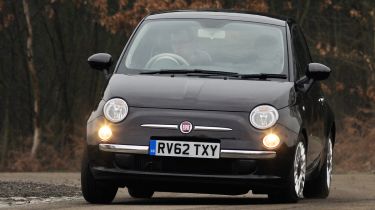Fiat 500 TwinAir
The chic Fiat 500 city car looks to prove that style is never out of fashion
The TwinAir engine doesn’t deliver on its economy claims, but it has the character and performance to help the 500 outshine the Vauxhall. Emissions of less than 100g/km mean free road tax, while strong residuals are another plus for private buyers. Factor in its eye-catching looks, lovable image and top value, and the Fiat just scrapes past the Vauxhall to take the win.
Fashion is normally a fickle beast, but five years on from its rebirth, the Fiat 500 is as chic as ever. And in 2012, the millionth example rolled off the production line – so it’s easy to see why Vauxhall wants a slice of this city car success story.
The Fiat’s charming retro looks still hit the spot, so it won’t be easy for any newcomer to take on such classless appeal. However, the 500 is looking a little outclassed inside.
The body-coloured dash and large speedo are neat retro details, but cabin quality isn’t a patch on the Vauxhall Adam’s, with hard, scratchy plastics and some flimsy fit and finish. The driving position isn’t great, either, as there’s no steering reach adjustment, and the seats aren’t as comfortable on long trips.
Unlike in the new Vauxhall, you’re always aware of the 500’s entry-level city car underpinnings – it’s based on the previous-generation Fiat Panda. Still, despite its dinky dimensions, it provides a similar amount of rear seat space to the Adam, plus its boot is longer and 15 litres larger, at 185 litres.
Used - available now

2021 Land Rover
Range Rover
27,750 milesAutomaticDiesel3.0L
Cash £49,995
2022 BMW
3 Series Touring
52,456 milesAutomaticDiesel2.0L
Cash £23,800
2018 Mazda
6 Saloon
48,985 milesAutomaticPetrol2.0L
Cash £12,600
2023 Mercedes
EQC
55,207 milesAutomaticElectric
Cash £22,300More importantly, the 500’s tiny turbocharged 875cc engine has the character and performance that’s missing from the uninspiring normally aspirated Vauxhall.
At idle there’s a gentle offbeat thrum and, while it’s a little gruff below 3,000rpm, the eager two-cylinder engine generates a healthy 145Nm of torque from as low as 1,900rpm, so it’s comfortably more responsive than the Adam.
However, working the TwinAir hard means you won’t get close to the claimed 70.6mpg economy. Over a couple of days of enthusiastic city and cross-country driving, we averaged just 35.9mpg, although this was still 3.2mpg up on the Vauxhall.
We also found pulling away smoothly could be a challenge in the 500, due to the combination of an engine that can bog down at low revs and a sluggish stop-start system.
The 500’s extra performance makes for easier overtaking, but refinement is no better than the Vauxhall’s. The vocal engine won’t be to all tastes, and there’s plenty of road noise on the motorway. Other gripes include sharp brakes that make it hard to slow down smoothly, and a slack throttle response.
At least the Fiat’s compact dimensions result in nimble handling, particularly around town. But at higher speeds big bumps upset the car’s composure in corners and under heavy braking, while there isn’t much feedback through the light steering. Also, with its smaller wheels and narrower tyres, the 500 runs out of grip sooner than the Adam. And unforgivably, stability control isn’t standard, either – it’s a £320 option.
Nonetheless, the Fiat is stylish, fun and easy to drive, packed with character and delivers strong performance.







